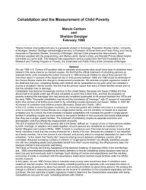
An official website of the United States government
Here’s how you know
Official websites use .gov
A .gov website belongs to an official government organization in the United States.
Secure .gov websites use HTTPS
A lock (
) or https:// means you’ve safely connected to the .gov website. Share sensitive information only on official, secure websites.
-
//
- Census.gov /
- Library /
- Census Working Papers /
- Cohabitation and the Measurement of Child Poverty
Cohabitation and the Measurement of Child Poverty
Cohabitation and the Measurement of Child Poverty
Abstract
We use 1990 U.S. Census of Population data to calculate what poverty rates would have been if cohabitors were treated in the same manner as married couples. We find that the official treatment of cohabiting partners as separate family units overstated the extent of poverty in 1989 among all children by about three percent. No more than about 11 percent of the observed rise in child poverty between 1969 and 1989 would be eliminated if the Census Bureau made this change in measurement procedures. We estimate a logistic regression model of the likelihood that poor, cohabiting families with children will be reclassified as non-poor when the cohabitor's income is included in family income. We find that the primary reason that many of these families remain poor is that the cohabitor has no earnings.
Others in Series
Working Paper
Working Paper
Working Paper
Share
Related Information
WORKING PAPER
Supplemental Poverty Measure Working PapersSome content on this site is available in several different electronic formats. Some of the files may require a plug-in or additional software to view.
 Yes
Yes
 No
NoComments or suggestions?


Top


